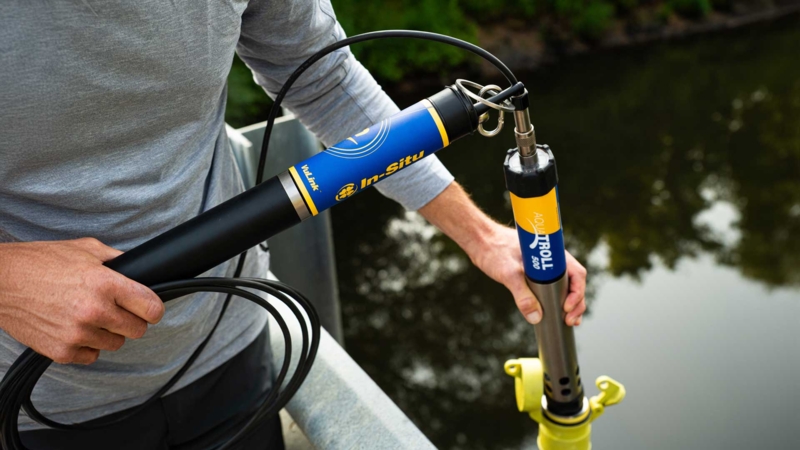Continuous Algal Bloom Monitoring for Source Waters
Published on by Marcus Miller, Digital Marketing Manager at In-Situ in Academic
Introduction
Monitoring algae levels in drinking water source waters, such as reservoirs, is crucial for ensuring proper treatment to protect drinking water quality, while simultaneously protecting ecosystem health. Excessive algae and cyanobacteria growth can lead to various environmental and public health concerns and monitoring for these parameters and others can aid in early detection and mitigation efforts.
However, to be effective, algae monitoring in source waters requires real-time data, detection of multiple algae species, and differentiation between harmless and harmful algae. Traditional monitoring methods often involve labor-intensive sampling and laboratory analysis, which may not provide timely information for proactive management. As an alternative, the Aqua TROLL platform is a versatile water quality monitoring instrument designed for continuous deployment in various aquatic environments. With a selection of fast-response sensors relevant to source waters and algae blooms, it offers a comprehensive solution for algae monitoring.
What and How to Monitor
Chlorophyll-a is a common pigmentation used by algae and some cyanobacteria for photosynthetic processes and is therefore a reliable indicator of algal biomass. Targeted excitation-emission wavelengths in the Aqua TROLL chlorophyll-a sensor can provide accurate insights into the abundance of these species in the water.
Cyanobacteria, or blue-green algae, are often referred to as harmful algal species that cause harmful algal blooms (HABs). These bacteria can release toxins that are harmful to human, animal and ecosystem health, so it’s imperative that they’re monitored. Phycocyanin sensors detect the blue-green pigmentation of cyanobacteria, which allows for differentiation between mostly harmless green algae and the potentially toxic cyanobacteria species.
Water temperature sensors are also useful; temperature is often an early indicator of when blooms will begin, since most algae species have specific requirements for growth. Depending on the species, algae bloom peak growth may occur at temperatures as low as 5 degrees Celsius up to 35 degrees Celsius or higher. There is no particular temperature at which all species will grow best, so it’s important to monitor temperature and become familiar with your local environmental triggers for these blooms.
Conductivity or salinity is another key indicator of whether algal species will be able to survive in the environment. Depending on the species, either freshwater or saltwater will offer a more favorable growing environment. In freshwater environments, a higher conductivity can also be indicative of nutrient influx, which supports the growth of these organisms.
Fluorescent dissolved organic matter (FDOM) sensors can be useful for predicting the onset of blooms because organic matter contains nutrients necessary for the growth and survival of algae and cyanobacteria. The humic, acid-like substances (large, varying combinations of carbon chains and rings) detected by this sensor are derived through naturally degraded plant matter. Cyanobacteria look for sources of carbon (such as bicarbonate) to aid in their photosynthetic processes, so by combining data from the FDOM sensor and pH sensor, early prediction of growth may be possible.
Algal and cyanobacteria blooms greatly affect water conditions. As photosynthesis and respiration occur, large swings in dissolved oxygen levels, from supersaturation to undersaturation, as well as pH add stressors to other species in the water body. Monitoring these parameters allows scientists to see the impact of blooms and evaluate the effectiveness of algae-management strategies and treatments.
Additionally, data on these parameters can be transmitted via the cellular telemetry device VuLink to the cloud-based data-hosting platform HydroVu. Regular data transmission informs timely decisions about source water usage for drinking water and recreation and treatment protocols. For sites lacking adequate cellular service, the TROLL Link 201 uses the Iridium satellite network for reliable data transmission from the most remote locations.
Benefits of the Aqua TROLL in Algae Monitoring
The Aqua TROLL Multiparameter Sonde, equipped with advanced sensor technology and real-time data transmission connection capabilities, enables early detection of algal blooms to support proactive management strategies. With built-in error protection, enhanced reliability and low-maintenance deployment, the Aqua TROLL enables proactive response to changing environmental conditions. And the cost and time savings realized with continuous monitoring vs. traditional sampling contributes to efficient monitoring practices.
Knowing rather than guessing when blooms are occurring streamlines relevant activities such as sampling, closing intakes, applying treatments or halting recreational use. By implementing algae monitoring with the Aqua TROLL, stakeholders can enhance environmental protection efforts, ensuring the sustainability of water resources and protection of public health.
Conclusion
Continuous monitoring of algae levels in source waters is essential for maintaining water quality and ecosystem health. The Aqua TROLL, equipped with a customizable array of sensors and connected to a telemetry device for real-time data transmission, enables early detection of algal blooms and supports proactive management strategies for the preservation of these waters now and into the future.
Learn more about the Aqua TROLL platform.
Taxonomy
- Drinking Water Treatment
- Water Quality
- Hydrodynamics & Water Quality
- Water Monitoring
- Algae
- Water Monitoring
- Drinking Water Managment
- Drinking Water
- Water Systems Monitoring
- Water Quality Management
- Water Quality Training
- Water Quality Monitoring
- Algae Treatment
- Water Quality Monitoring
- Water quality
- Water Quality Research
- Cyanobacteria
- Environmental Health systems thinking
- Algal Blooms
- Water Quality Monitoring Sensor
- Hazardous Algae Blooms
- Water Quality

